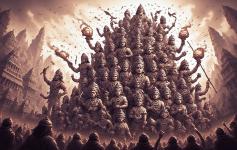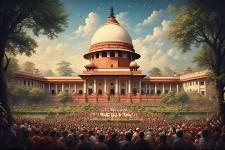Democracy
The Rational Apathy | Why India's Borrowed Framework Breeds Dysfunction
Posted on 6 mins
The casual observer might blame India’s civic dysfunction on cultural deficiency or innate selfishness. The streets are filthy, systems are routinely exploited, and apathy seems universal. But this explanation is too convenient—it mistakes symptom for cause. The real answer lies not in the character of Indians, but in the nature of the system they inhabit. The Paradox of Rational Selfishness Consider a simple game theory experiment: two players must independently choose between options A and B.
The Performance Problem | On Authenticity and Language in Modern India
Posted on 6 mins
There’s a peculiar phenomenon that runs through the fabric of contemporary Indian society—an overwhelming emphasis on appearance over substance, on the performance of values rather than their practice. From religious observance to professional life, from political discourse to educational pursuits, the culture has become profoundly ornamental. The talk is loud, but the sincerity is thin. The Politics of Symbols Nowhere is this performative tendency more evident than in political discourse.
The Scale Problem | Why Large Democracies Struggle with Social Revolution
Posted on 7 mins
TLDR - Summary: Large democracies face unique challenges that smaller nations avoid. India’s billion-plus population hasn’t created mathematical impossibility of consensus—it has culturally chosen to grant permanent veto power to street protests, making electoral democracy meaningless when any small group can endlessly occupy public spaces without consequence. While America demonstrates that democracies can be agile despite polarization (swinging between extremes every four years), India remains paralyzed by its need to accommodate everyone, ultimately accommodating no one.
The Kalki Paradox | Divine Intervention and the Pattern of Hindu Resistance
Posted on 9 mins
TLDR - Summary: The Jugantar revolutionary movement in early 20th-century Bengal exemplifies a recurring pattern in Hindu resistance: initial promise grounded in authentic cultural foundations, followed by secular dilution and organizational fragmentation. Founded on Sri Aurobindo’s vision of spiritual nationalism, these gymnasium-based revolutionary cells achieved tactical sophistication—publishing influential newspapers, organizing funding through ideologically-sanctioned robberies, and coordinating international conspiracies—yet ultimately dissolved into the Indian National Congress and various secular political factions.
The Indian Judiciary and Hinduism | Some notable examples of Blatant Bias
Posted on 9 mins
Read the Main Article here - A Comprehensive Indictment of the Anti-Hindu Judiciary of Modern India Judicial Views on Hinduism/Sanatana in India The Indian judiciary’s record on Hinduism and Sanatana Dharma is mixed. Supreme Court benches have often described Hinduism/Hindutva in broad, inclusive terms, but in practice some judges have made controversial remarks or rulings affecting Hindu practices. Critics point to instances of alleged bias or anti-Hindu actions. Below are key examples (with sources) of judges’ statements or rulings relating to Hinduism or religion:
The Indian Judiciary and Hinduism | A Critical Historical Analysis of Colonial Legacy and Contemporary Challenges
Posted on 12 mins
TLDR - Summary: The Systematic Judicial Assault on Sanatan Dharma: Three Centuries of Institutional Colonization This comprehensive analysis exposes the shocking truth: India’s judiciary has operated as an instrument of cultural colonization for over 250 years, systematically dismantling Hindu religious autonomy while masquerading as neutral arbiters of justice. The Colonial Foundation (1757-1947): British rulers didn’t merely govern India—they reconstructed Hindu law itself. Warren Hastings’ “codification” project and the 1864 dismissal of native religious authorities marked the beginning of epistemological warfare against dharmic jurisprudence.
Democracy and Secularism in India | Is it time to Change? Or was it Always Broken...
Posted on 9 mins
TLDR – Summary: India’s secular democracy is critiqued for suppressing Hindu interests and fostering division, with historical evidence and intellectual arguments supporting a shift to a Dharmic governance model that prioritizes duty, justice, and cultural continuity while addressing concerns about majoritarianism. The Mirage of Secular Democracy in India: A Case for a Dharmic Renaissance India’s secular-democratic framework, enshrined in its Constitution since 1950, is often celebrated as a triumph of unity in diversity.